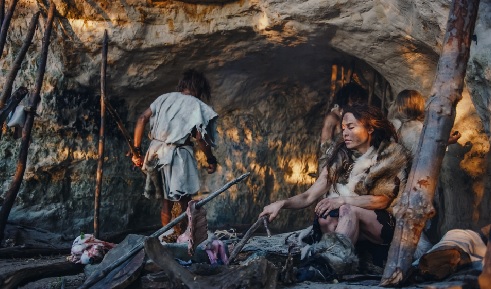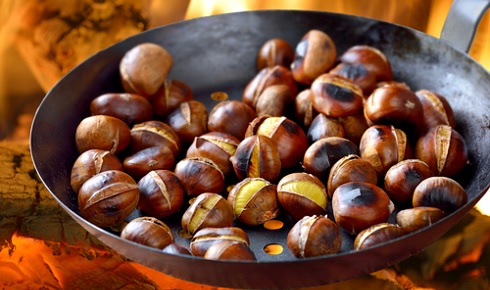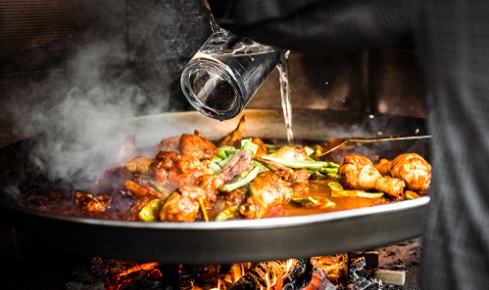Why do humans crave flavour?
The human craving for rich flavours has been a largely unacknowledged and unexamined force in our evolution, according to a new book that explores the concept of ‘deliciousness’ in nature
May 31st 2021
When Rob Dunn, an evolutionary biologist, and ecologist, and Monica Sanchez, an anthropologist, stopped to eat by some ruins on their favourite Croatian island a few years ago they began to think about the food of ancient people. Our own meals are about pleasure, but to ancient humans they would have been simply about survival. Or were they? The pair set out to investigate and found that neither of their fields had deeply considered the role of pleasure in the decisions our ancestors made. “In most scientific or scholarly work on the diets of early humans, the pleasure had been taken out of food,” they write in their new book, Delicious.
While many researchers have tried to work out the diets of early humans, and the role of hunting in the extinction of ancient animals, barely any research considers whether flavour influenced the species our ancestors chose to eat. The authors attempted to connect what is known about the needs of animals and early humans, what is known about how our senses have evolved, and what gastronomy tells us about the experience and importance of food in our culture, to better understand how ‘deliciousness’ has influenced the human story. In this exclusive extract, the pair explore how bipedalism may have impacted early humans’ ability to enjoy flavour.
Extract from Delicious: The evolution of flavour and how it made us human by Rob Dunn and Monica Sanchez
Roughly 75 million years ago, the primate family tree divided in two. One branch, the Strepsirrhini, became the lemurs, bush babies, and their relatives. The other branch, the Haplorhini, would beget modern monkeys, apes, and humans. As haplorhine noses and eyes evolved, some skull bones were lost – collateral damage associated with an imperfect process, the nuts and bolts left over after rebuilding things.
One of those bones was the transverse lamina, a long bone that helps to separate the mouth from the nose, a kind of shelf between the mouth floor and the nose floor of the head. The loss of the transverse lamina (also called the lamina transversalis) may have led many primate species, including apes such as gorillas and chimpanzees, to evaluate their food in a new way. Dogs sniff their food, then bite it. Once they have bitten it, the dominant experience of the food is simple and driven by the small palette of sensations the tongue offers. Bitter. Sweet. Umami. Sour. Salty. Not so for monkeys, apes, and other haplorhine primates. Each bite of their food has a taste and, within their mouth, also an aroma.
In humans, air being exhaled out of the lungs and along the length of the neck must make a right angle turn to exit via the nose. This sharp turn relates to the orientation of the nose relative to the head and to the way in which the neck is held relative to the body. In other primates, including chimpanzees and gorillas, the turn is less sharp. Daniel Lieberman speculates that the sharp turn around which exhaled air must travel during human exhalation may lead the air to bounce into the mouth and up through the nose, turbulently.
Experiments on cadavers seem to bear out Lieberman’s intuition. In bouncing turbulently, the exhaled air might spread even more aromas from the mouth to the nose. Finally, bipedal species also need to hold their food further forward in their mouths while chewing and manipulating it (in front of the epiglottis) or risk choking. Lieberman argues that this allows more time for retronasal aromas to be appreciated. Such aromas could be savoured while the tongue was manipulating the food, pushing it around and releasing volatile chemicals from the food’s bottom and then top and then bottom again.
As both Gordon Shepherd and Lieberman have highlighted, these evolutionary changes in noses, heads, and bodies make hominid olfaction in general, and human olfaction in particular, unusual. One result is that humans are less able to distinguish aromas in the soil than a dog or a pig can. But they are far better at being able to experience retronasal aromas as part of the experience of flavour.
No one has written a better description of the human experience of the way that flavour combines retronasal smell, taste, mouthfeel, and other experiences than what the French gastronome Jean Anthelme Brillat-Savarin penned in 1825. He was writing about the modern human experience. Yet, inasmuch as our noses and mouths have changed relatively little over the last four million years (at least compared to the extent to which they had changed previously), it is also probably a reasonable description of the eating experience of Australopithecus, ancient humans, and Neanderthals.
“As soon as an edible body has been put into the mouth, it is seized upon, gases, moisture, and all, without possibility of retreat. The mouth … is a cave in which aromas are trapped and seized upon. Lips stop whatever might try to escape; the teeth bite and break it; saliva drenches it; the tongue mashes and churns it; a breath-like sucking pushes it toward the gullet; the tongue lifts up to make it slide and slip; the sense of smell however, oh that sense of smell, appreciates it … without … a single atom or drop or particle having been missed by the powers of appreciation.”
 Early humans' behaviours may have been driven by a desire for complex flavours as well as calories.
Early humans' behaviours may have been driven by a desire for complex flavours as well as calories.
Side by side in the forest or dining room with a dog or a pig, you and a dog or pig perceive different worlds. We miss part of what the dog and pig perceive, but they miss part of what you perceive. We flounder when asked to find truffles, but excel at savouring their flavour. Dogs are good at finding truffles, but fail to enjoy their flavour. Meanwhile, the pig innately and lustily runs toward the truffle and probably doesn’t ever really know why. In this way, the truffle is a suitable emblem of some of the ways in which our sense of olfaction is unique, but also the extent to which the flavour world of each species is unique. One might argue, then, in returning to consider the story of ancient humans, that such humans were not only unique in their culinary traditions and cuisines, but also uniquely able to appreciate the flavours of foods, including their retronasal aromas.
A key question in considering aroma and human evolution is whether there are any aromas to which humans are innately drawn, or toward which we at least have some predisposition. As truffles are to pigs, what are to humans? No one knows. It is possible that some aroma associated with roasted meat was as instinctively attractive, once in the mouths of the first humans, as the aroma of truffles is to pigs. Or, our brains might be primed to learn to love such foods, but not hardwired to love them. Harold McGee, author of On Food and Cooking, has noted that one feature that many of the foods enjoyed by chimpanzees, gorillas, and humans share is that they tend to have very complex aromas. Recent studies of individual chemical compounds similarly note that humans, independent of their culture, ethnicity, or geographic origin, tend to find compounds that are complex to be more pleasing. Perhaps our brains are predisposed to learn to like a subset of complex aroma compounds and then also complex mixes thereof.
In Chinese there is a word, nung, which means, in the context of foods, ‘rich’. It describes the way in which the human palate likes “convoluted tastes, one leading to another in convoluted paths,” as Hsiang Ju Lin and her mother, Tsuifeng Lin, put it in Chinese Gastronomy. Once our ancestors discovered how to control fire, they found a way to alter foods, intentionally, so as to favour such complexity, which their brains may have been predisposed to love. And, compared to dogs or pigs, they especially loved such complexity once it could be savoured in their mouths.
Some aromas, such as those of the truffle, are complex by nature. Others are complex by culture, due to the ways that humans process food. Cooking meat is one of the ways that humans take something aromatically simple from nature and make it complex. At moderate temperatures, the chemicals in cooked meat that yield aromas come from chemical reactions in which the proteins, fats, and acids released from muscle cells combine, break apart, and become airborne. Meat begins to smell fruity, flowery, grassy, and nutty.
At high temperatures, however, something else entirely happens, and it happens not only to meat but also to vegetables. At high temperatures, the deliciousness of cooked foods is transformed by food chemistry, in a process so magical it gets a French name, the Maillard reaction. The Maillard reaction is named for the physician and chemist Louis Camille Maillard, who reported the discovery in 1912.
Maillard did not study food. He was instead trying to figure out how organisms assemble amino acids to make proteins. Toward this end, he mixed and then warmed amino acids and sugars together. When he did, he found that totally new compounds were produced, compounds that smelled good. Maillard had, unwittingly, mimicked part of the process of cooking. In cooking, just as in Maillard’s experiments, the mixture of amino acids and sugars under warm conditions produces new compounds. The compounds include pigments that make the surface of foods change texture and colour. These are the pigments we see when meats brown, breads crust, or malted barley is baked before brewing. But the process also yields hundreds of other compounds, many of them small enough to be airborne and hence sensed by our noses.
The Maillard reaction is chemistry inasmuch as it is subject to chemistry’s laws, but magic inasmuch as it remains both slightly unpredictable and incompletely understood. Every few years new chemical products of this reaction are revealed. It seems likely that they will continue to be revealed for many years to come; fire and fermentation are magicians that hide their best tricks. This aromatic complexity is characteristic of cooked meat, but also one of those things in nature that have evolved to attract animals to eat them, such as fruits. More than six hundred aromas have been identified from cooked beef. But this complexity is rivalled by that of fruit and fruitlike fungi such as truffles. Ripe strawberries produce 360 compounds, raspberries produce 200, blueberries produce 106.
Perhaps, as McGee argues, we are innately drawn to complex aromas. And perhaps, as McGee puts it, “cooking with fire was valued because it transformed blandness into fruitlike richness”. Cooking made meat, and also vegetables, complex. It turned the parts of plants and animals that did not evolve to be eaten into mixtures that cannot be improved upon, mixtures akin to those produced by fruits or truffles, and yet nonetheless distinct.
Delicious is published by Princeton Press.
Rob Dunn is a professor of applied ecology at North Carolina State University. Monica Sanchez is a medical anthropologist at Thompson Rivers University.


 Early humans' behaviours may have been driven by a desire for complex flavours as well as calories.
Early humans' behaviours may have been driven by a desire for complex flavours as well as calories. 


